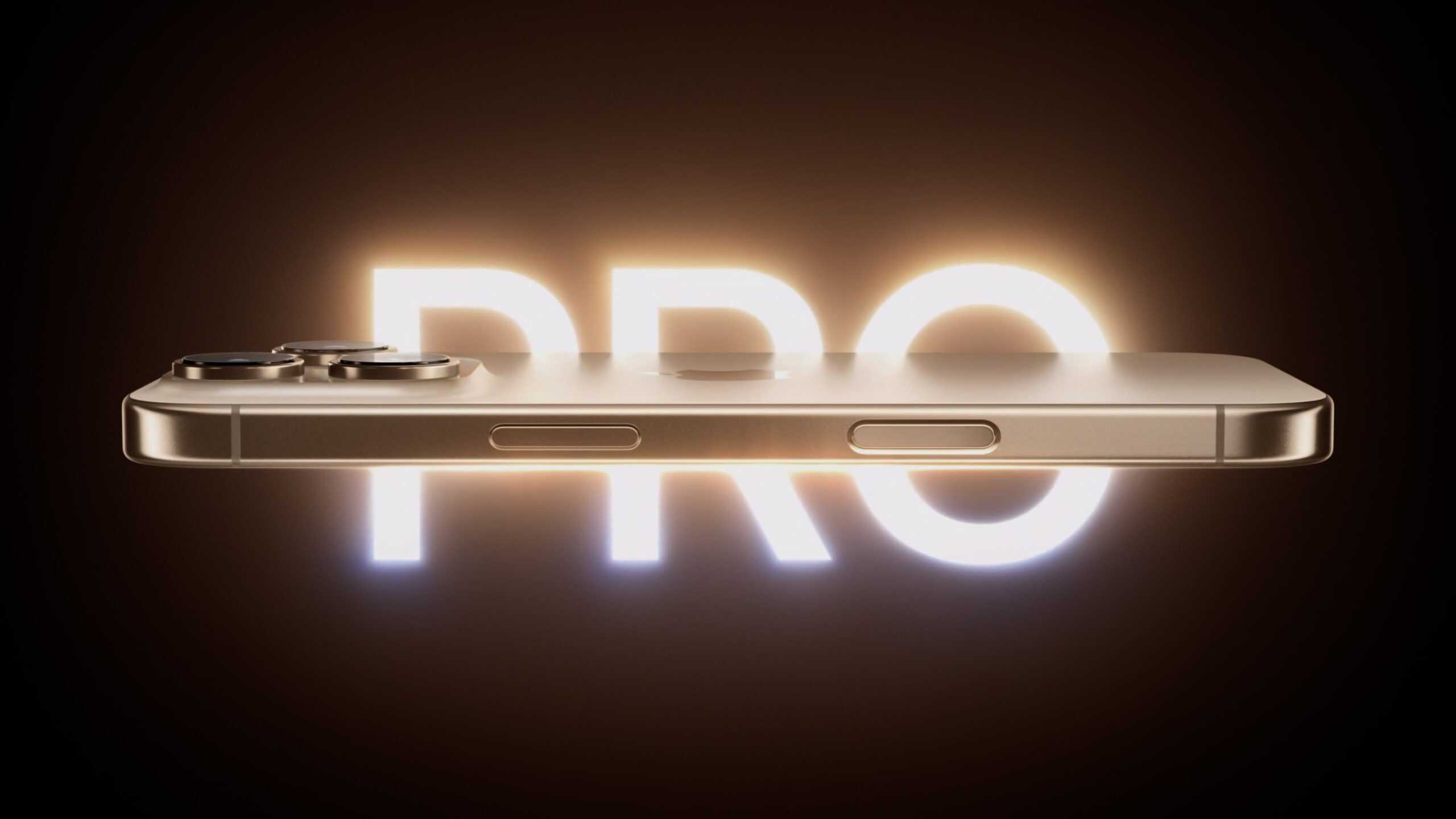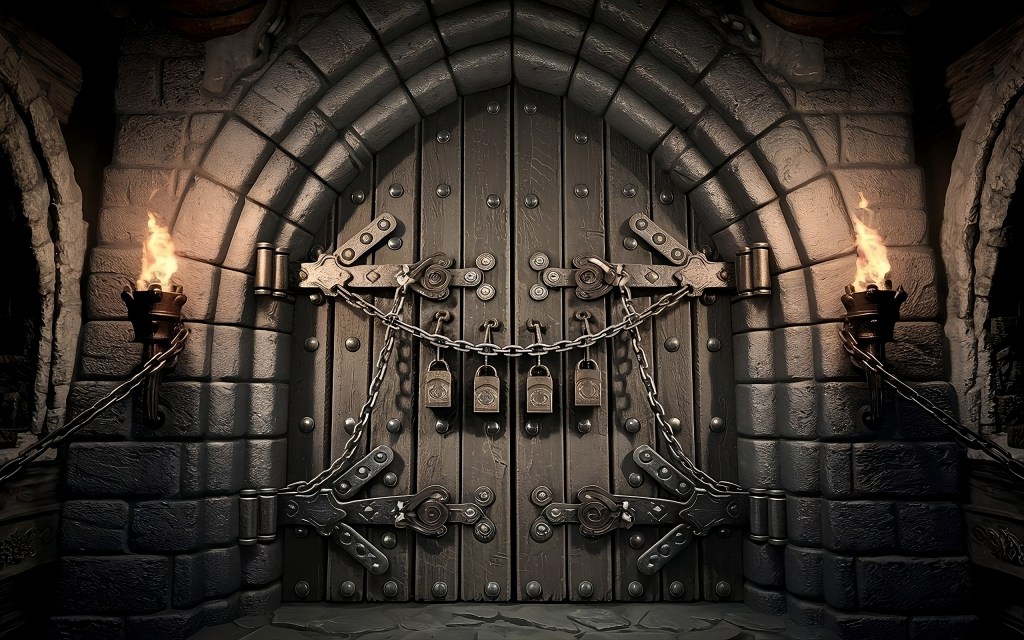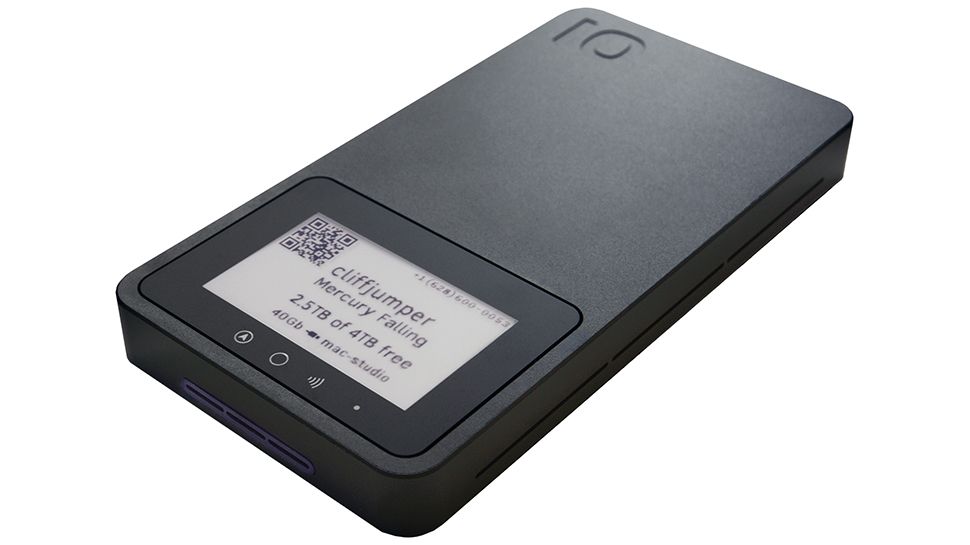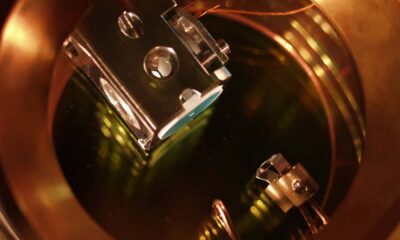Back in the Mad Men days, the only thing that might interrupt the corporate blandness of a workspace might be a photo of your family or maybe a coffee cup with a funny saying. But nowadays, especially if we’re working at home, we can have some pretty interesting, weird, or just plain nice-looking items on our desks.
Technology
iPhone 16 Pro’s durability test reveals a flaw of its ultra-thin bezels

Apple recently announced the most anticipated iPhone 16 series at the “It’s Glowtime” event. Now that the company has kicked off the sale of its latest iPhones, we are starting to see multiple durability test videos. So, if you are eager to watch how the iPhone 16 Pro stands out in the durability test, two YouTube channels, namely Apple Track and Tech Rax, have videos for you. To save you time, we have discussed the findings from the videos, keep reading.
iPhone 16 Pro durability test reveals a potential flaw related to its ultra-thin bezels
In the first video, Sam Kohl from Apple Track performs the casual drop putting the durability of the iPhone 16 Pro and iPhone 15 Pro to the test. Surprisingly, the iPhone 16 Pro took a hit on the bottom edge causing a minor dent in the first drop. What’s worse, it took Sam only four drops before making the iPhone 16 Pro unusable.
While dropping the iPhone 16 Pro from head over height, the display abruptly shut down. Meanwhile, he also noticed a crack at the right bottom of the screen which supposedly killed the display entirely. Sam speculates that this happened “because of the thinner bezels.” However, Sam noticed that the iPhone 16 Pro stood pretty firm over the course of testing.
He said there was “way less damage” in comparison to the iPhone 15 Pro. Moreover, Sam concluded the video by saying “On the iPhone 16 Pro, I think there’s a catch because the bezels are just so thin. So, when you’re getting something like a corner impact or something that just barely touches that edge of the screen, the display panel of the 16 Pro was extremely fragile and noticeably more so than on the 15 Pro.”
Keep the flagship iPhone far from a knife and a hammer, of course
If you want to see the iPhone 16 Pro’s durability put to the test vigorously, Tech Rax’s recent YouTube video is for you. In the video, the Titanium edges were easily scratched using a knife. Besides, the iPhone 16 Pro also goes through rigorous durability tests with the help of a hammer. You must be wondering if it passed the hammer drop test, right?
At first, the display held up pretty well with the hammer dropping from a height of a few inches. However, it was completely shattered after the next few drops. The same was the case when the hammer dropped right above the spot where the Apple packs the flagship’s battery. You can see it yourself in the video below.
Technology
A house haunted by AI and the mysterious murder of a superhero

New releases in fiction, nonfiction and comics that caught our attention.
An agoraphobic engineer named Henry spends his days locked away in his extremely smart home building freaky little robots, including one that looks like a magician and rides around on a tiny bike. His wife, Lily, is the only person he really ever sees, but things have grown tense between them — a situation only worsened by the fact that he’s usually holed up alone in the attic working on a secret project. One day, Lily invites some former coworkers over to encourage Henry to socialize, and Henry takes the opportunity to finally show off his greatest creation: William, an advanced AI system housed in a crude robot body. Horror ensues.
Mason Coile’s William (stylized W1LL1AM) takes the well-worn trope of a naive creator faced with their out-of-control creation and adds haunted smart-house creepiness, with a twist ending. Naturally, it’s drawn comparisons to Frankenstein and even The Shining, but I’d dare to say there’s a hint of Demon Seed in there, too. This is another short read, coming in at under 250 pages, and it’s just the right thing to get you into the spooky season mood. It takes place, appropriately, on Halloween.
Elon Musk’s acquisition of Twitter and its subsequent transformation into X as we now know it dominated headlines for months, so you couldn’t be blamed for feeling like you’ve heard all there is to know about the whole saga. But for those who do want a deeper look into how it all transpired, journalists Kate Conger and Ryan Mac have dredged up a ton of previously unreported information in their book Character Limit, which pulls from interviews with insiders and internal recordings from the rooms where it all went down to give us the full story of Twitter’s takeover. And it is a messy one.
I can’t think of another new series in recent memory that’s left me so hungry for the next issue as The Tin Can Society #1. Before I get into it, though, I should note that this first issue opens with a content warning about violence and discussions of ableism and racism. It is intense from the jump. The Tin Can Society begins with a crime scene: tech mogul turned superhero Johnny Moore has been murdered.
Moore, born with spina bifida, rose to fame as the genius creator of advanced exoskeleton-style mobility aids, and he wore a full-body armored version of one of these suits while operating as the vigilante hero, Caliburn. When he’s found dead, the suit is gone. The Tin Can Society follows Moore’s childhood friends, who come together after years apart to get to the bottom of his murder. There’s a lot of heart in the first issue as it bounces between their present-day setting and the past, building out the backstory of Moore’s early life and the tight-knit friend group that once was. I’m excited to see where this one goes. The Tin Can Society will be a nine-part mini series, and the next issue drops in late October.
Technology
‘Harvest now, decrypt later’: Why hackers are waiting for quantum computing

Join our daily and weekly newsletters for the latest updates and exclusive content on industry-leading AI coverage. Learn More
Hackers are waiting for the moment quantum computing breaks cryptography and enables the mass decryption of years of stolen information. In preparation, they are harvesting even more encrypted data than usual. Here is what businesses can do in response.
Why are hackers harvesting encrypted data?
Most modern organizations encrypt multiple critical aspects of their operations. In fact, about eight in 10 businesses extensively or partially use enterprise-level encryption for databases, archives, internal networks and internet communications. After all, it is a cybersecurity best practice.
Alarmingly, cybersecurity experts are growing increasingly concerned that cybercriminals are stealing encrypted data and waiting for the right time to strike. Their worries are not unfounded — more than 70% of ransomware attacks now exfiltrate information before encryption.
The “harvest now, decrypt later” phenomenon in cyberattacks — where attackers steal encrypted information in the hopes they will eventually be able to decrypt it — is becoming common. As quantum computing technology develops, it will only grow more prevalent.
How ‘harvest now, decrypt later’ works
Quantum computers make the “harvest now, decrypt later” phenomenon possible. In the past, encryption was enough to deter cybercriminals — or at least make their efforts pointless. Unfortunately, that is no longer the case.
Whereas classical computers operate using binary digits — bits — that can either be a one or a zero, their quantum counterparts use quantum bits called qubits. Qubits can exist in two states simultaneously, thanks to superposition.
Since qubits may be a one and a zero, quantum computers’ processing speeds far outpace the competition. Cybersecurity experts are worried they will make modern ciphers — meaning encryption algorithms — useless, which has inspired exfiltration-driven cyberattacks.
Encryption turns data, also known as plaintext, into a string of random, undecipherable code called ciphertext. Ciphers do this using complex mathematical formulas that are technically impossible to decode without a decryption key. However, quantum computing changes things.
While a classical computer would take 300 trillion years or more to decrypt a 2,048-bit Rivest-Shamir-Adleman encryption, a quantum one could crack it in seconds, thanks to qubits. The catch is that this technology isn’t widely available — only places like research institutions and government labs can afford it.
That does not deter cybercriminals, as quantum computing technology could become accessible within a decade. In preparation, they use cyberattacks to steal encrypted data and plan to decrypt it later.
What types of data are hackers harvesting?
Hackers usually steal personally identifiable information like names, addresses, job titles and social security numbers because they enable identity theft. Account data — like company credit card numbers or bank account credentials — are also highly sought-after.
With quantum computing, hackers can access anything encrypted — data storage systems are no longer their primary focus. They can eavesdrop on the connection between a web browser and a server, read cross-program communication or intercept information in transit.
Human resources, IT and accounting departments are still high risks for the average business. However, they must also worry about their infrastructure, vendors and communication protocols. After all, both client and server-side encryption will soon be fair game.
The consequences of qubits cracking encryption
Companies may not even realize they have been affected by a data breach until the attackers use quantum computing to decrypt the stolen information. It may be business as usual until a sudden surge in account takeovers, identity theft, cyberattacks and phishing attempts.
Legal issues and regulatory fines would likely follow. Considering the average data breach rose from $4.35 million in 2022 to $4.45 million in 2023 — a 2.3% year-over-year increase — the financial losses could be devastating.
In the wake of quantum computing, businesses can no longer rely on ciphers to communicate securely, share files, store data or use the cloud. Their databases, archives, digital signatures, internet communications, hard drives, e-mail and internal networks will soon be vulnerable. Unless they find an alternative, they may have to revert to paper-based systems.
Why prepare if quantum isn’t here yet?
While the potential for broken cryptography is alarming, decision-makers should not panic. The average hacker will not be able to get a quantum computer for years — maybe even decades — because they are incredibly costly, resource-intensive, sensitive and prone to errors if they are not kept in ideal conditions.
To clarify, these sensitive machines must stay just above absolute zero (459 degrees Fahrenheit to be exact) because thermal noise can interfere with their operations.
However, quantum computing technology is advancing daily. Researchers are trying to make these computers smaller, easier to use and more reliable. Soon, they may become accessible enough that the average person can own one.
Already, a startup based in China recently unveiled the world’s first consumer-grade portable quantum computers. The Triangulum — the most expensive model — offers the power of three qubits for roughly $58,000. The two cheaper two-qubit versions retail for less than $10,000.
While these machines pale in comparison to the powerhouse computers found in research institutions and government-funded labs, they prove that the world is not far away from mass-market quantum computing technology. In other words, decision-makers must act now instead of waiting until it is too late.
Besides, the average hacker is not the one companies should worry about — well-funded threat groups pose a much larger threat. A world where a nation-state or business competitor can pay for quantum computing as a service to steal intellectual property, financial data or trade secrets may soon be a reality.
What can enterprises do to protect themselves?
There are a few steps business leaders should take in preparation for quantum computing cracking cryptography.
1. Adopt post-quantum ciphers
The Cybersecurity and Infrastructure Security Agency (CISA) and the National Institute of Standards and Technology (NIST) soon plan to release post-quantum cryptographic standards. The agencies are leveraging the latest techniques to make ciphers quantum computers cannot crack. Firms would be wise to adopt them upon release.
2. Enhance breach detection
Indicators of compromise — signs that show a network or system intrusion occurred — can help security professionals react to data breaches swiftly, potentially making data useless to the attackers. For example, they can immediately change all employees’ passwords if they notice hackers have stolen account credentials.
3. Use a quantum-safe VPN
A quantum-safe virtual private network (VPN) protects data in transit, preventing exfiltration and eavesdropping. One expert claims consumers should expect them soon, stating they are in the testing phase as of 2024. Companies would be wise to adopt solutions like these.
4. Move sensitive data
Decision-makers should ask themselves whether the information bad actors steal will still be relevant when it is decrypted. They should also consider the worst-case scenario to understand the risk level. From there, they can decide whether or not to move sensitive data.
One option is to transfer the data to a heavily guarded or constantly monitored paper-based filing system, preventing cyberattacks entirely. The more feasible solution is to store it on a local network not connected to the public internet, segmenting it with security and authorization controls.
Decision-makers should begin preparing now
Although quantum-based cryptography cracking is still years — maybe decades — away, it will have disastrous effects once it arrives. Business leaders should develop a post-quantum plan now to ensure they are not caught by surprise.
Zac Amos is features editor at ReHack.
DataDecisionMakers
Welcome to the VentureBeat community!
DataDecisionMakers is where experts, including the technical people doing data work, can share data-related insights and innovation.
If you want to read about cutting-edge ideas and up-to-date information, best practices, and the future of data and data tech, join us at DataDecisionMakers.
You might even consider contributing an article of your own!
Source link
Technology
Electric outboard startup Pure Watercraft is selling itself for parts

A hopeful entrant in the emerging market of electric watercraft is out of action and being sold for parts.
Pure Watercraft was founded in 2011 with the intention of replacing gas-based outboard motors with fully electric ones. We covered the company in 2016 when it began taking preorders for its first commercial outboards, and in 2020 Pure raised $23 million to step up production. GM even took a 25% stake in Pure as part of its big investment in electric infrastructure.
The company offered a electric outboard and battery combo that could be mounted on a boat like any other outboard, or in a package with a rigid inflatable or pontoon boat. With prices ranging from $21,600 for just propulsion to nearly $100,000 for a full boat, Pure’s products were arguably no more affordable up front than gas options, but they were certainly a lot cleaner and quieter.
But a tough market seems to have put an end to Pure’s ambitions. The company entered receivership — a sort of alternative form of bankruptcy — in July, per filing documents in King County, Washington, where it is based. In August it was also reported that a planned multi-million-dollar factory in West Virginia would not be going forward.
The documents describe numerous creditors, from individual investors to banks to the big one, GM, which put approximately $35 million into the venture. That wasn’t all cash, though: listed among Pure’s assets is some $25 million worth of “manufacturing support,” “know-how,” licensing of the name, and other forms of non-pecuniary goods. (This type of in-kind investment is fairly commonplace.)
On the asset side, we find $3.6 million in “finished goods,” likely the assembled motors and battery units built by Pure, though why those would not have gone out to the more than 900 people who paid a down payment is unclear (nor is whether refunds will be issued). Another $25.5 million of “raw materials” is also listed, but what this may be is unclear — other documents detailing sale of assets like boats and batteries don’t come near that sum.
TechCrunch has asked both Pure and GM for comment on the matter. GM did not offer a substantive response and we have not yet heard back from Pure.
Electric watercraft is a growing but still nascent industry, with startups like Candela, Navier, FleetZero and Zin Boats making a play for cleaner, more efficient waterways and infrastructure.
Technology
The Verge’s favorite home office keepsakes

We asked the folks here at The Verge what they have on their desks or in their offices that they keep just for the hell of it — because they like it, because it means something special, or just because. Here are some of the answers we got.
A looping gif of our late cat Pouncey on my keyboard’s LCD
Antonio G. Di Benedetto, commerce / deals writer
One year ago, my wife and I were forced to say goodbye to one of our two beloved cats, Pouncey. She was a caring companion of over 11 years that my wife adopted as a kitten shortly before we started dating, making her a fixture in our relationship. That made it all the more traumatic when our farewell, due to her deteriorating health, was more sudden than expected. But in addition to all the photos and videos we have to remind us of our bestest girl (apologies to our eight-month-old daughter), I’m given a heart-warming reminder of Pouncey every time I sit down at my desk.
When I got my Meletrix Zoom75 mechanical keyboard from a long-awaited group buy preorder last year, I opted for the built-in LCD add-on because — well, why not? And, maybe unsurprisingly, once I built my board with that little screen inside it, I wondered, “Okay, what do I do with this thing?” So, I left it displaying something boring like battery level.
After Pouncey’s passing, I reconsidered the looping GIF feature and decided to put a cute clip of our girl on there. The GIF was just a burst of images from a random day, and if you look closely, you can see her eyes adorably widen once she notices me taking her picture. We now refer to it as The Pouncey Keyboard, and while it’s bittersweet to see her nuzzling on my desk but unable to feel her soft fur or hear her gentle purrs, I love seeing “our Pouncey-girl” every day.
The Legend of Zelda Heart Container Icon Light
Sean Hollister, senior editor
Whenever I’m feeling a little worn out, I’ve got an extra life sitting on my desk. My family bought me this Legend of Zelda heart container one year ago, so it encapsulates their love, too! (Less significant if you buy it for yourself, so I’d recommend gifting it instead.) It glows when you press the front button, and that’s it. Two AA batteries won’t power it for months on end, so turn it off when you’re feeling cheerful again! You can also import a Tears of the Kingdom version based on the newer game.
Command spring wall clips
Allison Johnson, reviewer
I get cold feet about putting nails in the wall in my office (which, incidentally, is also my bedroom). So, I end up with a pile of little things I kind of want to put on the wall but can’t commit to, like something my kid drew or the mess of tech event badges in my desk drawer. But recently, I’ve been on a command strip kick, putting up little hooks and clips around the house, and I started using them to decorate the wall behind my desk.
The clothespin-type clips are perfect; I can swap in a new piece of cute kid artwork whenever I want, and I don’t have to commit to their placement. That’ll come in handy if I want to rearrange my office — er, bedroom — and I’ve never had a problem taking them off the wall damage-free.
TWSBI Eco fountain pen
Adi Robertson, senior tech & policy editor
I keep a paper planner and notepad(s) for tracking stories and meetings, and the TWSBI Eco (in creme rose gold with burgundy Noodler’s ink) is my favorite writing implement for all of them. It’s a reasonably priced fountain pen that’s attractive, not hard to fill, and feels good to fidget with.
Link amiibo for The Legend of Zelda: Tears of the Kingdom
I’m not really one for desk trinkets, but I love this Link amiibo for The Legend of Zelda: Tears of the Kingdom. I get inspired by the way Link seems to be using his Ultrahand powers to craft a better world around him. If he can do it, maybe I can, too — though I might have to make things happen without a magical arm.
Kirby pencil case
Kylie Robison, senior AI reporter
My tiny Moleskine notebook keeps track of my whole life — I go through about two a year. That’s where I keep my weekly and monthly calendars, along with any source / general meeting notes. I use micron pens because they’re simply the best, and I keep them in a Kirby pencil case that I’ve even shown off in Verge videos (see above). I just recently redid my entire home office, and part of that was lots of decor, my favorite being an LED Majora’s Mask.
Dorothy Parker finger puppet
Barbara Krasnoff, reviews editor
I love Dorothy Parker, both for her writing and for her acrid personality. I once even bought a bottle of gin because it was named after her (and, to tell you the truth, it wasn’t half bad). So, when I spotted her among a plethora of famous people finger puppets at a book fair a few years ago, I simply had to buy it. The Parker puppet has a small magnet on the back of its head, so it can easily hang on any metal surface. In fact, I brought it with me when I started working at The Verge, and when I accidentally left it in the office during lockdown in 2020, I was bereft. Luckily, Dorothy hung in there throughout the pandemic, and she’s now back in my home office, grinning sardonically at me.
Cute desk note holder
Victoria Song, senior reviewer
A while back, a friend gave me this adorable cat-shaped desk note holder as a souvenir from Beijing. At first, I didn’t know what to do with it. Then, I started putting motivational notes into it, and surprisingly, that worked. After a while, I started printing or writing out the occasional meme. (Why, yes, I did write the entirety of Vice President Kamala Harris’ coconut tree speech on a Post-It one week.) When I’m really in need of strength, I stick on a photocard of my favorite K-pop singer.
This only really holds one note at a time, which helps keep me creative week-to-week. Most importantly, it reminds me to take breaks and laugh at myself whenever I get too self-serious. I don’t know where to get this exact desk note holder, but you can find a bunch of fun ones on Amazon and Etsy.
Technology
Obscure SSD vendor is using revolutionary cooling system in order to deliver best-in-class performance — iodyne’s portable SSD packs AirJet, iPhone connectivity and unique RAID-6 capabilities in a tiny footprint

iodyne has announced the Pro Mini SSD, a portable, bus-powered storage solution designed for professionals. The Pro Mini features a durable machined aluminum chassis with Frore AirJet membrane vibration cooling to prevent thermal throttling and ensure the SSD delivers consistent performance even under heavy data loads.
Iodyne claims the device achieves sustained performance of over 3GB/s, making it ideal for tasks like video editing, media offloading, and data transfer. Pro Mini provides solid security through XTS-AES-256 encryption and RAID-6 data protection, safeguarding data even in the event of a hardware failure. Passkeys replace traditional passwords, allowing users to securely unlock the device with their phone or computer. It offers NFC tap-to-unlock functionality too.
The SSD includes a customizable digital label that displays project names or other relevant information on its 2.1-inch e-ink display. The multiple containers feature allows users to divide the SSD into distinct partitions, each with its own filesystem.
Available in 4 and 8TB capacities
The Pro Mini comes with USB 4 and Thunderbolt (40 Gbps) ports so you can plug in a wide range of devices, including phones, tablets, cameras, and computers. Additionally, Find My tracking helps users locate lost or misplaced devices, while Fleet Management via the iodyne app allows for remote provisioning and management of multiple drives.
Mike Shapiro, Co-President iodyne said, “There is so much powerful performance and revolutionary engineering packed into the Pro Mini. Every single feature was thoughtfully designed with the specific needs of production professionals in mind – innovative breakthroughs thanks to our collaboration with Frore Systems to bring solid-state active cooling to portable SSDs.”
Pro Mini comes in 4TB and 8TB capacity, ideal for those needing to store large amounts of data, such as 4K video footage. It is available to preorder now and is expected to ship in Q1 2025.

More from TechRadar Pro
Technology
Meet Valkyrie, NASA’s humanoid robot paving way to the moon and Mars

Part Transformer, part Star Wars stormtrooper and with hands that look like they can crush beer cans, at 1.8 metres tall and weighing 120 kilograms, NASA’s Valkyrie robot is an intimidating figure. It is currently being put through its paces at the Karda laboratory in Australia so researchers can work out what it would take to get a humanoid robot onto offshore energy facilities or into space. New Scientist‘s James Woodford took the controls to see what the $2 million-plus device is capable of.
Topics:
-

 News3 days ago
News3 days agoYou’re a Hypocrite, And So Am I
-

 Sport2 days ago
Sport2 days agoJoshua vs Dubois: Chris Eubank Jr says ‘AJ’ could beat Tyson Fury and any other heavyweight in the world
-

 Science & Environment3 days ago
Science & Environment3 days agoHow to unsnarl a tangle of threads, according to physics
-

 Science & Environment2 days ago
Science & Environment2 days ago‘Running of the bulls’ festival crowds move like charged particles
-

 CryptoCurrency2 days ago
CryptoCurrency2 days agoEthereum is a 'contrarian bet' into 2025, says Bitwise exec
-

 Health & fitness3 days ago
Health & fitness3 days agoThe secret to a six pack – and how to keep your washboard abs in 2022
-

 CryptoCurrency2 days ago
CryptoCurrency2 days agoDorsey’s ‘marketplace of algorithms’ could fix social media… so why hasn’t it?
-

 News2 days ago
News2 days agoIsrael strikes Lebanese targets as Hizbollah chief warns of ‘red lines’ crossed
-

 Science & Environment2 days ago
Science & Environment2 days agoQuantum ‘supersolid’ matter stirred using magnets
-

 Sport2 days ago
Sport2 days agoUFC Edmonton fight card revealed, including Brandon Moreno vs. Amir Albazi headliner
-

 Science & Environment2 days ago
Science & Environment2 days agoHyperelastic gel is one of the stretchiest materials known to science
-

 Science & Environment3 days ago
Science & Environment3 days agoSunlight-trapping device can generate temperatures over 1000°C
-

 Science & Environment3 days ago
Science & Environment3 days agoHow to wrap your mind around the real multiverse
-

 Science & Environment3 days ago
Science & Environment3 days agoPhysicists are grappling with their own reproducibility crisis
-

 CryptoCurrency2 days ago
CryptoCurrency2 days agoBitcoin miners steamrolled after electricity thefts, exchange ‘closure’ scam: Asia Express
-

 CryptoCurrency2 days ago
CryptoCurrency2 days agoCardano founder to meet Argentina president Javier Milei
-

 CryptoCurrency2 days ago
CryptoCurrency2 days agoLow users, sex predators kill Korean metaverses, 3AC sues Terra: Asia Express
-

 Science & Environment3 days ago
Science & Environment3 days agoWhy this is a golden age for life to thrive across the universe
-

 Technology2 days ago
Technology2 days agoiPhone 15 Pro Max Camera Review: Depth and Reach
-

 Science & Environment3 days ago
Science & Environment3 days agoMaxwell’s demon charges quantum batteries inside of a quantum computer
-

 Science & Environment2 days ago
Science & Environment2 days agoQuantum forces used to automatically assemble tiny device
-

 Science & Environment2 days ago
Science & Environment2 days agoHow one theory ties together everything we know about the universe
-

 Science & Environment3 days ago
Science & Environment3 days agoTime travel sci-fi novel is a rip-roaringly good thought experiment
-

 Technology3 days ago
Technology3 days agoWould-be reality TV contestants ‘not looking real’
-

 Science & Environment3 days ago
Science & Environment3 days agoITER: Is the world’s biggest fusion experiment dead after new delay to 2035?
-

 Science & Environment3 days ago
Science & Environment3 days agoLiquid crystals could improve quantum communication devices
-

 Science & Environment3 days ago
Science & Environment3 days agoQuantum time travel: The experiment to ‘send a particle into the past’
-

 Science & Environment2 days ago
Science & Environment2 days agoNuclear fusion experiment overcomes two key operating hurdles
-

 CryptoCurrency2 days ago
CryptoCurrency2 days agoCertiK Ventures discloses $45M investment plan to boost Web3
-

 CryptoCurrency2 days ago
CryptoCurrency2 days agoDZ Bank partners with Boerse Stuttgart for crypto trading
-

 CryptoCurrency2 days ago
CryptoCurrency2 days agoRedStone integrates first oracle price feeds on TON blockchain
-

 CryptoCurrency2 days ago
CryptoCurrency2 days agoBitcoin bulls target $64K BTC price hurdle as US stocks eye new record
-

 CryptoCurrency2 days ago
CryptoCurrency2 days agoSEC asks court for four months to produce documents for Coinbase
-

 CryptoCurrency2 days ago
CryptoCurrency2 days ago‘No matter how bad it gets, there’s a lot going on with NFTs’: 24 Hours of Art, NFT Creator
-

 CryptoCurrency2 days ago
CryptoCurrency2 days agoBlockdaemon mulls 2026 IPO: Report
-
Business2 days ago
How Labour donor’s largesse tarnished government’s squeaky clean image
-

 CryptoCurrency2 days ago
CryptoCurrency2 days agoCoinbase’s cbBTC surges to third-largest wrapped BTC token in just one week
-

 News2 days ago
News2 days agoChurch same-sex split affecting bishop appointments
-

 Politics4 days ago
Politics4 days agoTrump says he will meet with Indian Prime Minister Narendra Modi next week
-

 MMA2 days ago
MMA2 days agoDiego Lopes declines Movsar Evloev’s request to step in at UFC 307
-

 Science & Environment2 days ago
Science & Environment2 days agoHow to wrap your head around the most mind-bending theories of reality
-

 Technology4 days ago
Technology4 days agoCan technology fix the ‘broken’ concert ticketing system?
-

 News5 days ago
News5 days agoDid the Pandemic Break Our Brains?
-

 Science & Environment2 days ago
Science & Environment2 days agoA new kind of experiment at the Large Hadron Collider could unravel quantum reality
-

 Politics2 days ago
Politics2 days agoLabour MP urges UK government to nationalise Grangemouth refinery
-

 Science & Environment2 days ago
Science & Environment2 days agoHow Peter Higgs revealed the forces that hold the universe together
-

 News2 days ago
News2 days agoBrian Tyree Henry on voicing young Megatron, his love for villain roles
-
Business4 days ago
Glasgow to host scaled-back Commonwealth Games in 2026
-

 Science & Environment3 days ago
Science & Environment3 days agoX-ray laser fires most powerful pulse ever recorded
-

 Science & Environment3 days ago
Science & Environment3 days agoBeing in two places at once could make a quantum battery charge faster
-

 CryptoCurrency2 days ago
CryptoCurrency2 days ago2 auditors miss $27M Penpie flaw, Pythia’s ‘claim rewards’ bug: Crypto-Sec
-

 CryptoCurrency2 days ago
CryptoCurrency2 days agoJourneys: Robby Yung on Animoca’s Web3 investments, TON and the Mocaverse
-

 CryptoCurrency2 days ago
CryptoCurrency2 days agoLouisiana takes first crypto payment over Bitcoin Lightning
-

 CryptoCurrency2 days ago
CryptoCurrency2 days agoAre there ‘too many’ blockchains for gaming? Sui’s randomness feature: Web3 Gamer
-

 CryptoCurrency2 days ago
CryptoCurrency2 days ago$12.1M fraud suspect with ‘new face’ arrested, crypto scam boiler rooms busted: Asia Express
-

 CryptoCurrency2 days ago
CryptoCurrency2 days ago‘Everything feels like it’s going to shit’: Peter McCormack reveals new podcast
-

 Science & Environment2 days ago
Science & Environment2 days agoA single atom could drive a piston in a quantum engine
-

 Science & Environment2 days ago
Science & Environment2 days agoTiny magnet could help measure gravity on the quantum scale
-

 Science & Environment2 days ago
Science & Environment2 days agoUK spurns European invitation to join ITER nuclear fusion project
-

 Science & Environment2 days ago
Science & Environment2 days agoA tale of two mysteries: ghostly neutrinos and the proton decay puzzle
-

 Science & Environment2 days ago
Science & Environment2 days agoFuture of fusion: How the UK’s JET reactor paved the way for ITER
-

 CryptoCurrency2 days ago
CryptoCurrency2 days agoDecentraland X account hacked, phishing scam targets MANA airdrop
-

 CryptoCurrency2 days ago
CryptoCurrency2 days agoCZ and Binance face new lawsuit, RFK Jr suspends campaign, and more: Hodler’s Digest Aug. 18 – 24
-

 CryptoCurrency2 days ago
CryptoCurrency2 days agoBeat crypto airdrop bots, Illuvium’s new features coming, PGA Tour Rise: Web3 Gamer
-

 CryptoCurrency2 days ago
CryptoCurrency2 days agoMemecoins not the ‘right move’ for celebs, but DApps might be — Skale Labs CMO
-

 CryptoCurrency2 days ago
CryptoCurrency2 days agoBitcoin bull rally far from over, MetaMask partners with Mastercard, and more: Hodler’s Digest Aug 11 – 17
-

 CryptoCurrency2 days ago
CryptoCurrency2 days agoTelegram bot Banana Gun’s users drained of over $1.9M
-

 CryptoCurrency2 days ago
CryptoCurrency2 days agoVonMises bought 60 CryptoPunks in a month before the price spiked: NFT Collector
-

 CryptoCurrency2 days ago
CryptoCurrency2 days agoVitalik tells Ethereum L2s ‘Stage 1 or GTFO’ — Who makes the cut?
-

 CryptoCurrency2 days ago
CryptoCurrency2 days agoEthereum falls to new 42-month low vs. Bitcoin — Bottom or more pain ahead?
-

 CryptoCurrency2 days ago
CryptoCurrency2 days agoETH falls 6% amid Trump assassination attempt, looming rate cuts, ‘FUD’ wave
-

 News2 days ago
News2 days agoSean “Diddy” Combs denied bail again in federal sex trafficking case
-

 Technology2 days ago
Technology2 days agoFivetran targets data security by adding Hybrid Deployment
-

 Science & Environment3 days ago
Science & Environment3 days agoElon Musk’s SpaceX contracted to destroy retired space station
-

 Money3 days ago
Money3 days agoWhat estate agents get up to in your home – and how they’re being caught
-

 Technology5 days ago
Technology5 days ago‘The dark web in your pocket’
-

 Business4 days ago
Business4 days agoGuardian in talks to sell world’s oldest Sunday paper
-
News2 days ago
Freed Between the Lines: Banned Books Week
-

 MMA2 days ago
MMA2 days agoUFC’s Cory Sandhagen says Deiveson Figueiredo turned down fight offer
-

 Football2 days ago
Football2 days agoNiamh Charles: Chelsea defender has successful shoulder surgery
-

 Football2 days ago
Football2 days agoSlot's midfield tweak key to Liverpool victory in Milan
-

 Science & Environment2 days ago
Science & Environment2 days agoThe physicist searching for quantum gravity in gravitational rainbows
-

 Fashion Models2 days ago
Fashion Models2 days agoMiranda Kerr nude
-

 Fashion Models2 days ago
Fashion Models2 days ago“Playmate of the Year” magazine covers of Playboy from 1971–1980
-

 Politics4 days ago
Politics4 days agoTrump Media breached ARC Global share agreement, judge rules
-

 Health & fitness3 days ago
Health & fitness3 days ago11 reasons why you should stop your fizzy drink habit in 2022
-

 Fashion Models2 days ago
Fashion Models2 days agoMixte
-

 Science & Environment2 days ago
Science & Environment2 days agoOdd quantum property may let us chill things closer to absolute zero
-

 Science & Environment2 days ago
Science & Environment2 days agoRethinking space and time could let us do away with dark matter
-

 Business4 days ago
Business4 days agoDangers of being a FOMO customer as rates fall
-

 Health & fitness4 days ago
Health & fitness4 days agoHow to start exercising again after having Covid-19
-

 News3 days ago
News3 days ago▶️ Media Bias: How They Spin Attack on Hezbollah and Ignore the Reality
-

 Health & fitness3 days ago
Health & fitness3 days agoAnxiety robbed me of my sleep – and by 32, my life was a car crash
-

 Science & Environment3 days ago
Science & Environment3 days agoLaser helps turn an electron into a coil of mass and charge
-

 Science & Environment3 days ago
Science & Environment3 days agoAre space and time illusions of entanglement? The answer could lie in black holes
-

 Science & Environment3 days ago
Science & Environment3 days agoQuantum to cosmos: Why scale is vital to our understanding of reality
-
Business4 days ago
BP’s US wind sale will not clear its strategic fog
-

 News4 days ago
News4 days agoItaly braces for rain as 21 killed in Europe floods
-

 Science & Environment3 days ago
Science & Environment3 days agoNegative temperature: Atoms beyond absolute zero may be a new form of matter
-

 Science & Environment3 days ago
Science & Environment3 days agoHow materials that rewind light can test physics’ most extreme ideas




You must be logged in to post a comment Login